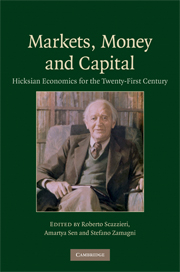Book contents
- Frontmatter
- Contents
- List of figures
- List of tables
- List of contributors
- Preface and acknowledgments
- Between theory and history: on the identity of Hicks's economics
- Part I The Intellectual Heritage of John Hicks
- Part II Markets
- Part III Money
- Part IV Capital and Dynamics
- 15 ‘Distribution and Economic Progress’ after seventy years
- 16 Flexible saving and economic growth
- 17 The economics of non-linear cycles
- 18 A perspective on a Hicksian non-linear theory of the trade cycle
- 19 Capital, growth, and production disequilibria: on the employment consequences of new technologies
- 20 Capital and time
- 21 Sequential analysis and out-of-equilibrium paths
- References
- Name index
- Subject index
17 - The economics of non-linear cycles
Published online by Cambridge University Press: 29 June 2009
- Frontmatter
- Contents
- List of figures
- List of tables
- List of contributors
- Preface and acknowledgments
- Between theory and history: on the identity of Hicks's economics
- Part I The Intellectual Heritage of John Hicks
- Part II Markets
- Part III Money
- Part IV Capital and Dynamics
- 15 ‘Distribution and Economic Progress’ after seventy years
- 16 Flexible saving and economic growth
- 17 The economics of non-linear cycles
- 18 A perspective on a Hicksian non-linear theory of the trade cycle
- 19 Capital, growth, and production disequilibria: on the employment consequences of new technologies
- 20 Capital and time
- 21 Sequential analysis and out-of-equilibrium paths
- References
- Name index
- Subject index
Summary
Introduction
John Hicks's contribution to dynamics has been particularly relevant. While Capital and Growth (1965) and Capital and Time (1973a) embrace a long-run perspective, A Contribution to the Theory of the Trade Cycle (1950a) is set in a medium-term framework. According to Robert Solow (2000), the adoption of such a perspective implies entering a ‘no man's land.’ Most of the literature on dynamics is concerned with either the short-run fluctuations of the economy or of its long-run tendencies. In a medium-run perspective, endogenous forces have to be identified because the lapse of time involved is such that the dynamics of the model cannot depend only on exogenous shocks. Hicks's contribution to the business cycle is an ‘endogenous’ explanation with two methodological characteristics:
a macro approach,
based upon a piecewise linear technique.
Both the conclusion and the two characteristics of Hicks's analysis stand in strong contrast to the present ‘mainstream’ theories, which favor ‘exogenous’ interpretations based upon a stochastic approach, are micro-founded, and are linearized around the steady-state values. The dynamic stochastic general equilibrium approach, which is based upon these three tenets, is at the root of both the real business cycle and the so called ‘New Keynesian’ approach. In these models, it is very difficult to identify conclusions in keeping with Hicksian thought. In order to find them, one must look elsewhere. For instance, Hashem Pesaran and Simon Potter (1997) have recently reconsidered the ‘ceiling and floor’ model in a time-series perspective.
- Type
- Chapter
- Information
- Markets, Money and CapitalHicksian Economics for the Twenty First Century, pp. 309 - 327Publisher: Cambridge University PressPrint publication year: 2009



